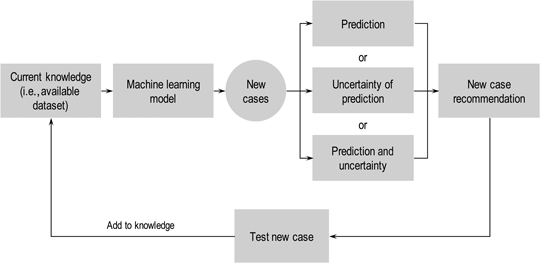Crossref Citations
This article has been cited by the following publications. This list is generated based on data provided by
Crossref.
Batra, Rohit
Tran, Huan Doan
Kim, Chiho
Chapman, James
Chen, Lihua
Chandrasekaran, Anand
and
Ramprasad, Rampi
2019.
General Atomic Neighborhood Fingerprint for Machine Learning-Based Methods.
The Journal of Physical Chemistry C,
Vol. 123,
Issue. 25,
p.
15859.
del Rio, Beatriz G.
Kuenneth, Christopher
Tran, Huan Doan
and
Ramprasad, Rampi
2020.
An Efficient Deep Learning Scheme To Predict the Electronic Structure of Materials and Molecules: The Example of Graphene-Derived Allotropes.
The Journal of Physical Chemistry A,
Vol. 124,
Issue. 45,
p.
9496.
Sharma, Bineet
Ma, Yutao
Ferguson, Andrew L.
and
Liu, Allen P.
2020.
In search of a novel chassis material for synthetic cells: emergence of synthetic peptide compartment.
Soft Matter,
Vol. 16,
Issue. 48,
p.
10769.
Doan, Hieu A.
Agarwal, Garvit
Qian, Hai
Counihan, Michael J.
Rodríguez-López, Joaquín
Moore, Jeffrey S.
and
Assary, Rajeev S.
2020.
Quantum Chemistry-Informed Active Learning to Accelerate the Design and Discovery of Sustainable Energy Storage Materials.
Chemistry of Materials,
Vol. 32,
Issue. 15,
p.
6338.
Chapman, James
and
Ramprasad, Rampi
2020.
Predicting the dynamic behavior of the mechanical properties of platinum with machine learning.
The Journal of Chemical Physics,
Vol. 152,
Issue. 22,
Ziatdinov, Maxim
Kim, Dohyung
Neumayer, Sabine
Vasudevan, Rama K.
Collins, Liam
Jesse, Stephen
Ahmadi, Mahshid
and
Kalinin, Sergei V.
2020.
Imaging mechanism for hyperspectral scanning probe microscopy via Gaussian process modelling.
npj Computational Materials,
Vol. 6,
Issue. 1,
Morgan, Dane
and
Jacobs, Ryan
2020.
Opportunities and Challenges for Machine Learning in Materials Science.
Annual Review of Materials Research,
Vol. 50,
Issue. 1,
p.
71.
Antono, Erin
Matsuzawa, Nobuyuki N.
Ling, Julia
Saal, James Edward
Arai, Hideyuki
Sasago, Masaru
and
Fujii, Eiji
2020.
Machine-Learning Guided Quantum Chemical and Molecular Dynamics Calculations to Design Novel Hole-Conducting Organic Materials.
The Journal of Physical Chemistry A,
Vol. 124,
Issue. 40,
p.
8330.
Webb, Michael A.
Jackson, Nicholas E.
Gil, Phwey S.
and
de Pablo, Juan J.
2020.
Targeted sequence design within the coarse-grained polymer genome.
Science Advances,
Vol. 6,
Issue. 43,
Chen, Lihua
Kim, Chiho
Batra, Rohit
Lightstone, Jordan P.
Wu, Chao
Li, Zongze
Deshmukh, Ajinkya A.
Wang, Yifei
Tran, Huan D.
Vashishta, Priya
Sotzing, Gregory A.
Cao, Yang
and
Ramprasad, Rampi
2020.
Frequency-dependent dielectric constant prediction of polymers using machine learning.
npj Computational Materials,
Vol. 6,
Issue. 1,
Shmilovich, Kirill
Mansbach, Rachael A.
Sidky, Hythem
Dunne, Olivia E.
Panda, Sayak Subhra
Tovar, John D.
and
Ferguson, Andrew L.
2020.
Discovery of Self-Assembling π-Conjugated Peptides by Active Learning-Directed Coarse-Grained Molecular Simulation.
The Journal of Physical Chemistry B,
Vol. 124,
Issue. 19,
p.
3873.
Batra, Rohit
Song, Le
and
Ramprasad, Rampi
2020.
Emerging materials intelligence ecosystems propelled by machine learning.
Nature Reviews Materials,
Vol. 6,
Issue. 8,
p.
655.
Batra, Rohit
Dai, Hanjun
Huan, Tran Doan
Chen, Lihua
Kim, Chiho
Gutekunst, Will R.
Song, Le
and
Ramprasad, Rampi
2020.
Polymers for Extreme Conditions Designed Using Syntax-Directed Variational Autoencoders.
Chemistry of Materials,
Vol. 32,
Issue. 24,
p.
10489.
Kamal, Deepak
Chandrasekaran, Anand
Batra, Rohit
and
Ramprasad, Rampi
2020.
A charge density prediction model for hydrocarbons using deep neural networks.
Machine Learning: Science and Technology,
Vol. 1,
Issue. 2,
p.
025003.
Sattari, Kianoosh
Xie, Yunchao
and
Lin, Jian
2021.
Data-driven algorithms for inverse design of polymers.
Soft Matter,
Vol. 17,
Issue. 33,
p.
7607.
Tao, Lei
Chen, Guang
and
Li, Ying
2021.
Machine learning discovery of high-temperature polymers.
Patterns,
Vol. 2,
Issue. 4,
p.
100225.
Marques, Gabriel
Leswing, Karl
Robertson, Tim
Giesen, David
Halls, Mathew D.
Goldberg, Alexander
Marshall, Kyle
Staker, Joshua
Morisato, Tsuguo
Maeshima, Hiroyuki
Arai, Hideyuki
Sasago, Masaru
Fujii, Eiji
and
Matsuzawa, Nobuyuki N.
2021.
De Novo Design of Molecules with Low Hole Reorganization Energy Based on a Quarter-Million Molecule DFT Screen.
The Journal of Physical Chemistry A,
Vol. 125,
Issue. 33,
p.
7331.
Garland, Anthony P.
White, Benjamin C.
Jensen, Scott C.
and
Boyce, Brad L.
2021.
Pragmatic generative optimization of novel structural lattice metamaterials with machine learning.
Materials & Design,
Vol. 203,
Issue. ,
p.
109632.
Dhamankar, Satyen
and
Webb, Michael A.
2021.
Chemically specific coarse‐graining of polymers: Methods and prospects.
Journal of Polymer Science,
Vol. 59,
Issue. 22,
p.
2613.
Yuan, Qi
Longo, Mariagiulia
Thornton, Aaron W.
McKeown, Neil B.
Comesaña-Gándara, Bibiana
Jansen, Johannes C.
and
Jelfs, Kim E.
2021.
Imputation of missing gas permeability data for polymer membranes using machine learning.
Journal of Membrane Science,
Vol. 627,
Issue. ,
p.
119207.





